Indian or Indians refers to people or things related to India, or to the indigenous people of the Americas, or Aboriginal Australians until the 19th century.

North America is a continent entirely within the Northern Hemisphere and almost all within the Western Hemisphere. It can also be described as a northern subcontinent of the Americas, or America, in models that use fewer than seven continents. It is bordered to the north by the Arctic Ocean, to the east by the Atlantic Ocean, to the west and south by the Pacific Ocean, and to the southeast by South America and the Caribbean Sea.

Baja California Sur, officially the Estado Libre y Soberano de Baja California Sur, is the second-smallest Mexican state by population and the 31st admitted state of the 32 states which make up the 32 Federal Entities of Mexico.

Mexicans are the people of Mexico, a country in North America.
Latin Americans are the citizens of the Latin American countries and dependencies. Latin American countries are multi-ethnic, home to people of different ethnic and national backgrounds. As a result, some Latin Americans do not take their nationality as an ethnicity, but identify themselves with both their nationality and their ancestral origins. Aside from the indigenous Amerindian population, all Latin Americans or their ancestors immigrated since 1492. Latin America has the largest diasporas of Spaniards, Portuguese, Black Africans, Italians, Lebanese and Japanese in the world. The region also has large German, French, and Jewish diasporas.
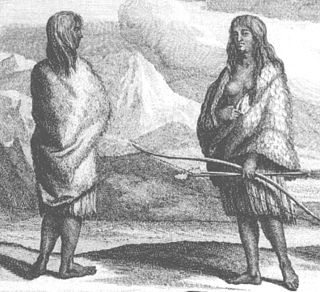
The Pericú were the aboriginal inhabitants of the Cape Region, the southernmost portion of Baja California Sur, Mexico. They have been linguistically and culturally extinct since the late 18th century.
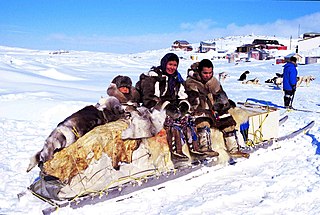
The indigenous peoples of the Americas are the pre-Columbian peoples of North, Central and South America and their descendants.

Many different languages are spoken in Mexico, though Spanish is the most widespread. The indigenous languages are from eleven distinct language families, including four isolates and one that immigrated from the United States. The Mexican government recognizes 68 national languages, 63 of which are indigenous, including around 350 dialects of those languages. The large majority of the population is monolingual in Spanish. Some immigrant and indigenous populations are bilingual, while some indigenous people are monolingual in their languages. Mexican Sign Language is spoken by much of the deaf population, and there are one or two indigenous sign languages as well.
Indigenous peoples of Mexico, Native Mexicans, or Mexican Native Americans, are those who are part of communities that trace their roots back to populations and communities that existed in what is now Mexico prior to the arrival of Europeans.
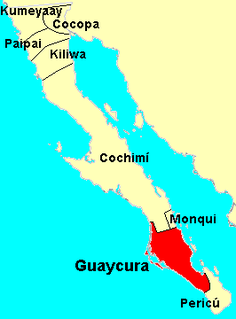
The Guaycura were a native people of Baja California Sur, Mexico, occupying an area extending south from near Loreto to Todos Santos They contested the area around La Paz with the Pericú. The Guaycura were nomadic hunter-gatherers. They are distinguished by a language unrelated to any other Native American language, indicating in the opinion of some linguists that their ancestry in Baja California dates back thousands of years.

The Monqui were indigenous peoples of Mexico, who lived in the vicinity of Loreto, Baja California Sur, Mexico, at the time of Spanish contact. Monqui territory included about 65 kilometres (40 mi) of coast along the Gulf of California and extended a few kilometers inland to where the Cochimi people lived.

Johann Jakob Baegert was a Jesuit missionary at San Luis Gonzaga in Baja California Sur, Mexico. He is noted for his detailed and acerbic account of the peninsula, the culture of its native inhabitants, and the history of its Spanish exploration and missionization.

Misión San Juan Bautista Malibat, also known as the Misión San Juan Bautista de Ligüí, was founded by the Jesuit missionary Pedro de Ugarte in November 1705, about 30 kilometres (19 mi) south of Loreto near the Gulf of California coast of what is today the Mexican state of Baja California Sur. The mission is located at 25°44′22″N111°15′51″W.

Mission Santiago was founded by the Italian Jesuit Ignacio María Nápoli in 1724 and financed by the Marqués de Villapuente de la Peña and his wife the Marquesa de las Torres de Rada, at the native settlement of Aiñiní, about 40 kilometers north of San José del Cabo in the Cape Region of Baja California Sur, Mexico.
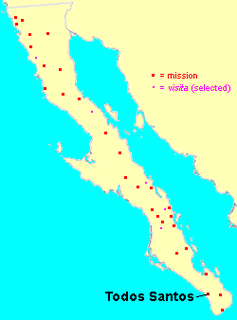
Misión Santa Rosa de las Palmas, also known as Todos Santos Mission, was founded by the Roman Catholic Jesuits in 1733. After 1748, the mission was known as Nuestra Señora del Pilar de la Paz. The mission was the first European settlement at the site of what is now the city of Todos Santos, Baja California Sur. The Santa Rosa Mission was located in one of the few areas of Baja California suitable for agriculture. The residents of the Mission were primarily Guaycura Native Americans whom the Jesuits and their successors, the Franciscans and Dominicans, attempted to convert to Christianity and to make into sedentary farm workers. Recurrent epidemics of introduced European diseases reduced the Indian population to only a handful by the 19th century and in 1825 the mission was closed.
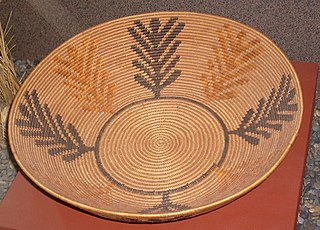
El Vallecito is an archaeological site located in the city of La Rumorosa, in the Tecate Municipality, Baja California, Mexico.

Waikuri is an extinct language of southern Baja California spoken by the Waikuri or Guaycura people. The Jesuit priest Baegert documented words, sentences and texts in the language between 1751 and 1768.

Pericú is the extinct and essentially unattested language of the Pericú people who lived at the southern tip of Baja California. Jesuit missionaries recognized it as distinct from Waikuri (Guaycura) immediately to the north. It was spoken in the mountainous area around the mission of San José del Cabo, on the southeastern coast from Santiago to La Paz, and on the islands off the east coast as far north as Isla San José.













